Hello Dolls!
It's getting awfully cold out there! We have some amazing vintage winter coats in the shop right now so we thought we'd give you a little history on Midcentury outerwear!
1940's Coat Styles
1940s coats during the war years were restricted by L-85, but there weren’t many rules. Coats could not have a bi-swing back, could not have more than two pockets, and had a limitation on sleeve circumference that really only eliminated exaggerated sleeve types, such as the bell shaped Dolman sleeve that was popular in the 1930s. Most coats were made from wool and rayon-wool blends, many re-purposed wool from used coats and wool blankets.
Linings were made of rayon crepe or satin. Most coats followed the same basic style with a few alternatives. They were long, coming to just below the knee, and were frequently made in herringbone, tan, grey, dark green, navy and red among other winter colors. They were generally without decoration and all had large square shoulder pads. The look was borrowed from men’s military coats.
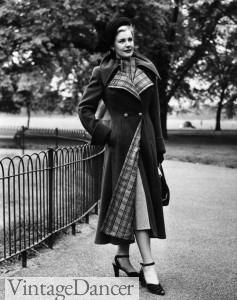
One popular men’s and women’s style was the wool trench coat. It was somewhat loose-fitting, but not over sized. It had a pointed collar and one or two rows of buttons down the front. A belt about two inches thick tied or buckled at the waist. The trench usually had two slit pockets on the sides.
The men’s Chesterfield coat had a female counterpart too. It had wide peak lapels with a contrasting black trim along the back neck piece. It would come in all classic coat silhouettes as long as it had black trim.
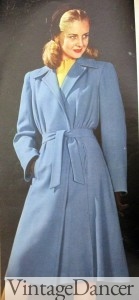
Another style of coat, the tailored or swagger coat, was slightly more fitted through the waist and flared out slightly from there. It usually had one row of buttons, but could have two. It could have slit pockets on the sides or two large patch pockets on the front. The collar was pointed or oversize peter pan (many made of fur). This type of coat also sometimes had a fur collar – fox being the most popular or rabbit dyed to look like fox. The fur collar would look like a small shawl draped over the top of the coat. Fur-trimmed coats were dressier and often had cloth-covered buttons or a cloth belt.
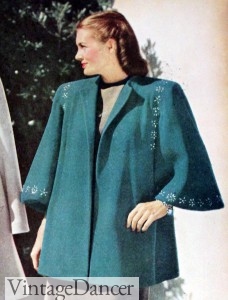
One of the most iconic coat style of the ’40s and ’50s was the polo coat or box coat. It was cut very straight and wide, in the shape of a box, and was oversized. They hung open like in the one pictured, or buttoned closed with large, covered buttons. Box coats hung down just to the mid hip, making them good light weight coats for fall and swing or nice evening wear when made of velvet or exotic fur.
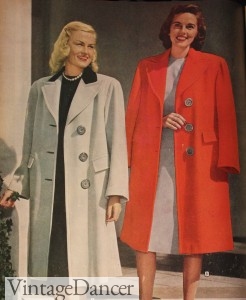
A long version of the box coat was the swagger style. It fit wide and boxy but came down to below the knee. In the mid to late ’40s the back of the coat often had swing pleats coming from the nape of the neck. This allowed extra movement and more room for clothing underneath. It wasn’t uncommon for a dress or suit to come with a matching coat for a fully coordinated look.
Raincoats
New inventions during and after the war led to new treatments for waterproofing fabrics. However, most 1940s raincoats were made of cotton Gabardine. They were mostly turned into rain capes or simple utility coats with padded shoulders, wide lapels and collars and big belts forming the typical masculine/military shape. Hemlines rose to just below the knee (their legs must have always been cold and wet) and colors dulled down into drab military hues. What is remarkable about the 1940s is the new coat styles that emerged during the decade have stayed with us ever since.
The utility coat or shop coat was a practical but not too pretty raincoat. The trench coat was the newest style and one that is a still a classic today. The wrap coat was the most feminine design.
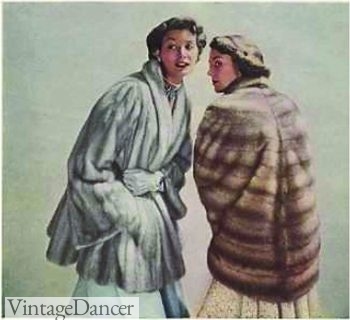 Fur coats were worn in the same shapes as the fabric coats above. The box coat and swagger style looked best with thick fox, sable, and seal fur. Sleeves were wide and open and collars were high and closed with a longer hair fur piece trimming the collar. To keep with the simple and polished style of fur coats only two or three buttons or clasps kept the coat closed. Some box styles only had a single clasp at the neckline.Pockets were hidden slashes on the coat sides. The beauty of the fur must be the showcase of a woman’s 1940s fur coat!
Fur coats were worn in the same shapes as the fabric coats above. The box coat and swagger style looked best with thick fox, sable, and seal fur. Sleeves were wide and open and collars were high and closed with a longer hair fur piece trimming the collar. To keep with the simple and polished style of fur coats only two or three buttons or clasps kept the coat closed. Some box styles only had a single clasp at the neckline.Pockets were hidden slashes on the coat sides. The beauty of the fur must be the showcase of a woman’s 1940s fur coat!1950's Style Coats
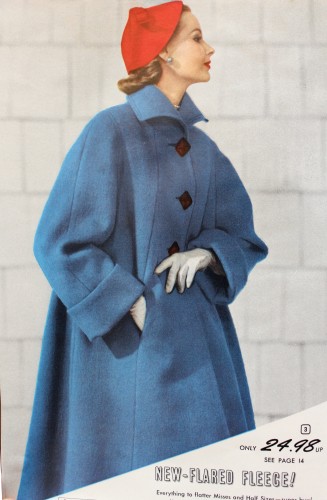
Coats were usually either very fitted, semi fitted, or full and swingy. The full coat was the most common style, although there was not a strict name for this style. For that matter, coat was not a common name in the ’50s. Instead, they were called toppers or top coats. Duster coat, Pea Coat, Long Coat, Swing Coat, Pyramid coat, Princess Coat, and Bell Coat were all used to identify ’50s full fitting coats. Full coats had wide sleeves, a triangular shape, large cuffs, and collars and usually large buttons, too. They came in long (to mid shin) or short (hip lengths). As we know, the fifties are synonymous with full skirts, and dresses and skirts with a fuller bottom were easily worn with a coat that had a straight slim style. Also, after the war we saw a boom in births, so coats that were swing style were very roomy and worked well for women who were pregnant. This was one more step a woman could take to be out in public without “showing” too much. This was a radical step at the time.
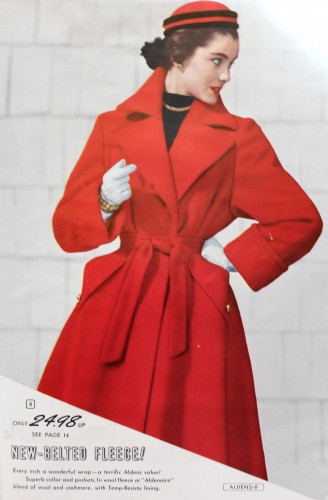
Much like the desired figure of the fifties, many vintage coatshad belts that accented the waist and flared at the bottom. Sometimes known as the princess style, these coats were feminine, pretty and figure hugging. Popular colors were royal blue, dark red, gray, hunter green, dusty rose, black, and tan. Some coat sleeves had wide cuffs at the end or large covered buttons to add some decoration. Coats had buttons up the front, usually from the waist to the neck or just from the chest to the neck, and collars came up high and protected the back of the neck. Coats without buttons were a wrap over style similar to a trench coat.
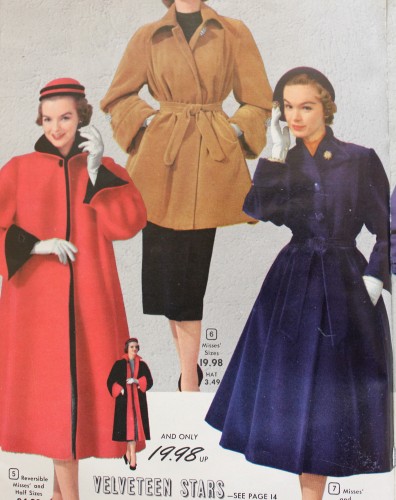
Many coats added pretty details with contrast stitching or embroidery, self fabric belts and decorative elaborate buttons. Most coats conveniently had hidden pockets. Coat collars came in all shapes and sizes, and some were made of fur. The round over-sized “peter pan” or “puritan style” collar was especially popular on 1950s coats. It helped make coats appear childlike or doll-like, which was the goal for women’s 1950s fashion.
As for any well groomed woman of the fifties, it’s all about completing the look. That meant winter stockings, coordinating gloves, a matching hat, and usually a leather purse. A fur muff was borrowed by Victorian and earlier times and became a fashionable accessory to wear with fur or fur trimmed coats.
1950s Swing Coat
The swagger coat was neatly tailored and fit close to the body through the waist and was wider at the bottom. It is the most common style available in repro and inspired 1950s clothing. Depending on the desired look, it usually had buttons from the chest to the waist or could be double breasted. Large pleats on the back added extra room for movement that “swung” as a woman walked, hence the swing coat name. Sometimes with a belt or sometimes without, this style coat was very flattering and mimicked the same hourglass shape that was popular at the time. The idea was to mimic the dress that was worn underneath the coat. It was a style also borrowed from Victorian ice skating coats.
1950s Box Coat
1950s Box Coat
In reverse, the coat dress was inspired by the swagger coat. It was a dress with the double breasted rows of buttons on the bodice and full swing skirt. It was a dress style only worn in the fall and winter. Read more about the coat dress here.
Another style is the box coat or half coat, which is arguably one of the most iconic styles of the 1940s and ’50s. It hung very wide and straight, much like the shape of a box. They either hit at the bottom of a woman’s hips or went all the way to mid-shin. The 1950s versions often had a fuller shape than the 1940s box coats. Large pleats at the back shoulder line created a swing coat meets box coat look.
Collars, pockets and buttons were large. Most came in solid colors: ivory/cream, black, blue, red, or brown. The only popular pattern was checks.
1950s Lightweight Spring Coats
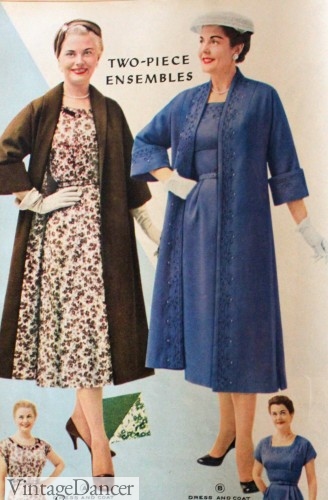
Many coats that came as coordinated sets with dresses were not heavy winter coats. Instead, they were lightweight Spring and Fall top coats that came in many names such as Clutch coat or Tuxedo coat. They often did not have pointed collars, but instead folded shawl collars that ran the length of the long coat. They were made of lightweight wools, cotton blends and new synthetics.
Unlike winter coats, sleeves were cut full but not wide, folded up to mid arm and the amount of “swing” at the back was minimal so that the coat hung straight over a dress. They hardly ever had buttons to hold them close, exposing the dress underneath and the matching lining found inside the coat. Decorative embroidery was more likely seen on fashion coats than on winter coats.
1950s Fur Coats
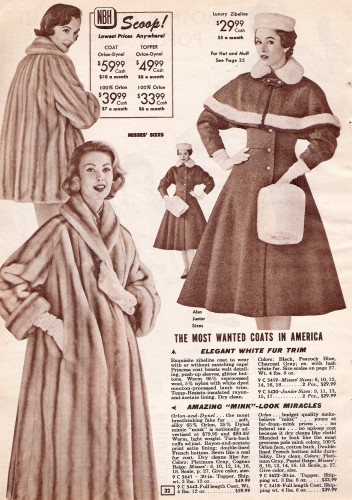
Fur coats were glamorous and dressier than the everyday coat (for most people). They were cut in the same shapes as other coats of the fifties. The box coat and swagger style looked best with thick fox, sable and seal fur. Faux furs were an option for the less affluent as well as cheap squirrel and marmot dyed to look like sable. Sleeves were wide and open and collars were high and closed with a longer hair fur piece trimming the collar. To keep with the simple and polished style of fur coats, only two or three buttons or clasps kept the coat closed. Some box styles only had a single clasp at the neckline. Pockets were hidden slashes on the coat sides. The beauty (and wealth) of the woman must be the showcase of her 1950s fur coat!
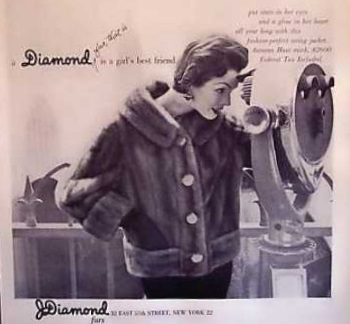
Late 1950s Short Mink Coat
While most fur coats were full length or at least hip length, a few came in shorter waist length styles. The cape coat, popular in the 1940s remained common into the 1950s as well. Coats like this short fur Diamond brand coat (right) became increasingly popular in the late ’50s and ’60s when styles favorited the slim sheath dress rather than the full circle dress.
For those who could not afford a full full coat, fur stoles, muffs and shawls were a popular alternative. Fur trim on short or long jackets also added a touch of richness without the shocking price tag.
1950s Rain Coats
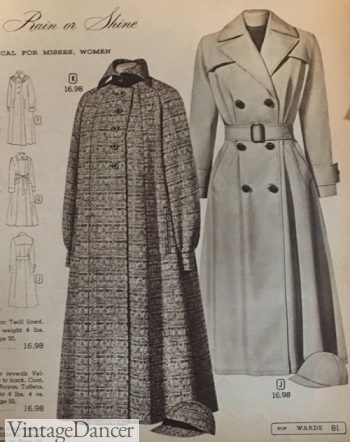
1950s raincoats were not longer, just utilitarian and plain. They now came in fun patterns, such as the raining umbrellas in the above ad. They were made of a cotton+ synthetic blended fabric for light waterproofing. Some were made of plastic (clear, color or patterned) that fit like a poncho hood and an elastic or wrap belt. Non-rubberized raincoats existed in the form of waterproof tweed, corduroy and gabardine fabrics with an optional zip-in lining for warmth.
1950s raincoats mostly came in trench coat style with a single or double breast and belt. They often had matching hats, too. The above are Jockey style hats, while most others were detached hoods with the brim folded back (or not when raining). Popular colors were bright red, navy blue, medium blue, turquoise, and grey.
For the rebellious youth and especially Art students, the trend was to wear black raincoats. These also became associated with prostitutes, although I don’t know why. “Good women” chose brighter colors (pink, turquoise, red, yellow) and avoided dark colors, which were hard to be seen in the rain anyways. Read more details about vintage raincoats.
1950s Winter Jackets
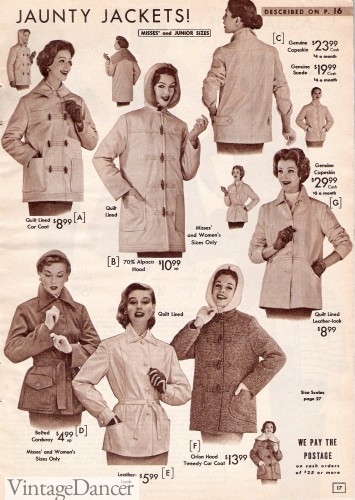
While the most fashionable coat was the long coat or half coat, there were numerous needs for less formal, but very practical winter jackets. Jackets were worn paired with long skirts or pants and were reserved for colder climate with excessive rain and snow. While useful, they were not entirely void of styles. Hip length, with tie belts and point or round collars were trademarks of the ’50s. They came in warm quilted lined flannel, cotton or fur insides with leather, faux leather, tweed or corduroy exteriors.
Less winter friendly jackets had fashionable style all of their own. Many were influenced by western styles featuring fringe leather, plaid patterns, and leather or suede looking materials. The “motorcycle” jacket below, top, right, was a style borrowed from menswear. Jacket styles have a whole other history unto themselves, but they are also difficult to research.
So come down to Paper Doll Vintage and check out our selection of true vintage unique coats, capes and jackets!
Source:
https://vintagedancer.com/1940s/1940s-coats-women/
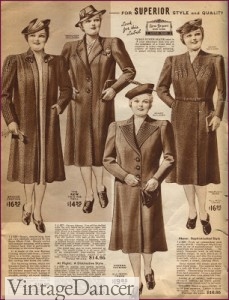
No comments:
Post a Comment